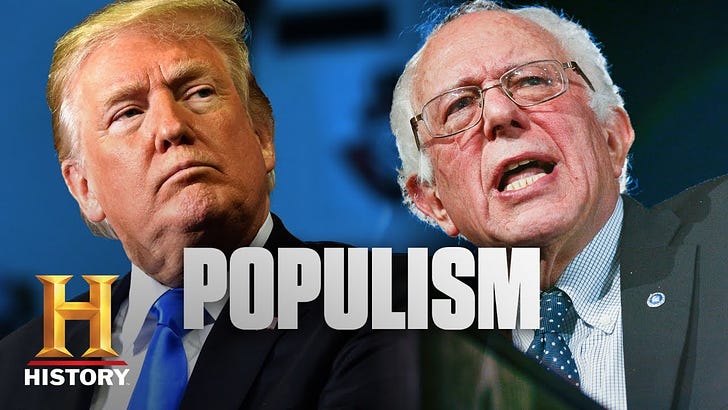Hello! And welcome to another edition of Inside The Newsroom! Lots of exclamation marks today as we passed 2,500 subscribers over the weekend! Thank you for being part of this — I’m very humbled! Right, today’s guest is… Krystal Ball, former Democrat congressional candidate and co-host of Rising, The Hill’s daily political show. Krystal’s book, The Populist’s Guide To 2020!, co-authored with Saagar Enjeti, will be out on February 8, so we got into all the contents of the book, as well as The New York Times’ somewhat bizarre dual endorsement of Elizabeth Warren and Amy Klobuchar. Below is a post-game analysis, but first, my favorite articles over the past week. Enjoy 🤓
Remembering Kobe and Gianna Bryant — The world stopped on Sunday when we learned of the passing of Kobe and Gianna Bryant
Facebook is turning into a Republican platform — Who are the Republican political operatives calling the shots at Facebook?
Greece elects first female president — High court judge and human rights advocate secures backing of left- and right-wing parties
Krystal 👇

What Is a Populist Anyway?
Great question. Merriam Webster describes a populist as “a member of a political party claiming to represent the common people.” But as we’ve experienced just in the past two election cycles, populists and populism can come in all shapes and sizes. Take populist-in-chief Donald Trump, for example, whose 2017 inauguration speech was littered with populist sentiment, perhaps none more so than when he remarked
“For too long, [those in politics] have reaped the rewards of government while people have borne the cost. Washington flourished, but the people did not share in its wealth.”
Perhaps the most common misconception of populism is that it only comes from the right. Cross the aisle into the Democratic Party and you’ll find a whole host of populists, and politicians pinching nuggets of populism to forward their agenda. Bernie Sanders is the most well-known populist on the left right now, but let’s not forget how Barack Obama too railed against the greed of Wall Street among other populist themes to help his 2012 reelection bid.
Mark Rice-Oxley and Ammar Kalia, The Guardian
Quick plug for my conversation with Ryan Grim, D.C. bureau chief for The Intercept and author of the book We’ve Got People, a history of progressivism in the Democratic Party.
How Old Is Populism?
Populism is as old as democracy itself and it’s almost impossible to pinpoint the exact period when populism was first used for political gain. Throughout the 20th century, populism was mostly associated with the rightwing — a German politician in the 1930s and 40s had a lot to do with that. But as we know, populism comes from the left and the right. According to Cas Mudde, a professor of international affairs at the University of Georgia, it was the 2008 financial crash that freed populism from the stigma of being attached to the radical right. The rise of Syriza and Podemos in Spain are prime examples. Like with most things, though, Trump’s presence on the political scene amplified the term to meteoric heights, as outlined by Google searches of the term ‘populism’, of which will only increase as we get deeper into 2020.
The Meaning Behind the New York Times’ Dual Endorsement
Unless you’ve been living under a rock, you’ll know that the New York Times broke tradition and endorsed two Democrats for the party’s presidential nominee. The paper’s editorial board put their weight behind Elizabeth Warren and Amy Klobuchar. In their own words, the Times feels that the duo are “the most effective advocates for each approach,” the two approaches being a radical overhaul of essential programs and institutions, and a steadier let’s-not-ruffle-too-many-feathers strategy.
But what makes the endorsements utterly confusing, and painfully ironic, is the fact that the Times picked two candidates who have little chance of winning the nomination. Not that newspaper endorsements even matter, Warren is currently third in the race, according to FiveThirtyEight, and has tanked since her debacle with Bernie. As for Klobuchar, the senator from Minnesota is outside the top four, and has a three percent chance of winning the Iowa caucuses. Turns out the Times’ “most effective advocates” won’t be very effective at all.
The Editorial Board, The New York Times
Are Bernie and Liz Really That Different Then?
For many progressives, choosing between Bernie and Liz was like choosing between a tangerine and a clementine: Both pretty juicy, with one being sweeter than the other. Both candidates are vocal about reining in society’s richest and eliminating corporate greed, both want Medicare for all, and both have extensive plans to deal with the climate crisis. But if the NYT is honest about choosing Warren because she’s the candidate who’ll most likely get things done in government, then there must be key differences between the Bernie and Liz campaigns. Sure, there are inevitable nuances between the two candidates’ policies — Bernie has stated that he wants to eliminate all undergraduate college tuition at four-year public colleges and universities, while Warren wants to cancel up to $50,000 of student loan debt. But overall, they really aren’t that different. Despite their “beef” from the other week, I maintain that I’d be happy with either candidate winning the nomination. With that said, I guess the main difference between the two is that Bernie is leading the polls and Warren isn’t.
Why Won’t the MSM Embrace Bernie?
The most frustrating thing to see over the past half a decade is the mainstream media’s treatment of Sanders. Like many of us, I have good friends that work for the largest newspapers and cable outlets, so this is of course not a dig at every single journalist whose LinkedIn profile includes the likes of CNN or The Washington Post. It’s also obvious that just because you work for an organization, it doesn’t mean that you subscribe to agreeing on everything your outlet publishes. I for one don’t agree with 100 percent of the content The Guardian puts out. That said, it’s hard to ignore how differently Sanders has been covered compared with Hillary Clinton in 2016, and now the likes of Warren and Joe Biden in the 2020 cycle.
This goes further and deeper than merely preferring one candidate over another, which I don’t think journalists should be get into. As Krystal elegantly pointed out in the podcast, the Democratic Party has become more and more fractured, and as it has done so, the NYT have had no qualms about representing the portion of voters who are socially liberal, yet are moderate or even drift into Republican territory when it comes to economics. I have few problems with that. But when the Times states publicly that its aim is to grow digital revenue beyond $800 million, alienating the sizeable portion of progressives in the process is counterintuitive and hard to believe that they’re still the paper of the left.
Please Like Me, Thanks
Thanks for making it to the end. Please like this edition of Inside The Newsroom by clicking the ❤️ below the title. That way I’ll appear in clever algorithms and more people will be able to read.
Related Episodes…
#56 — Jamil Smith (Rolling Stone) on voter suppression and the life of Elijah Cummings
#51 — Jason Kander (Democratic Party) on PTSD and the forgotten veterans
#47 — Ryan Grim (The Intercept) on the history of progressivism in the Democratic Party
#34 — Dave Weigel (Washington Post) on the differences between the left in the U.S. and the UK
Last Week…
#61 — Rachel Botsman (Trust Issues) on the why people believe fake news
… Next Week
We’ll have Paula Jean Swearengin, who was one of the main characters alongside Alexandria Ocasio-Cortez in the Netflix documentary Knock Down The House, and currently a candidate for the U.S. Senate from West Virginia.
Job Corner
Each week I’ll feature a selection of new journalism jobs. The 19th launched this week, which is a nonprofit newsroom focusing on women’s issues at the intersection of gender politics and policy. They have a ton of openings, including…
Women & Congress Reporter
Women’s Health Reporter
Women & The Economy Reporter
Statehouses Reporter
General Assignment Reporter (x2)
Breaking News Reporter
Newsletter Editor
Data Visuals Reporter
Director of Product & Engineering
Experience Designer
Product Engineer
Creative Director
Audience Editor
Community Manager














Share this post